A Unionid Mussel Biodiversity Hotspot Experiencing Unexplained Declines: Evaluating the Influence of Chemical Stressors Using Caged Juveniles
Abstract
1. Introduction
2. Materials and Methods
2.1. Study Area
2.2. Mussel Propagation, Deployment, and Collection
2.3. Environmental Media Collection, Laboratory Analyses, and Quality Control
2.4. Statistical Analyses
2.4.1. Recovery and Survival
2.4.2. Growth
2.4.3. Trace Element Concentrations in Mussel Shells
2.4.4. Tissue Concentrations of Potential Toxicants
3. Results
3.1. Differences Between Silos and Cages
3.2. Spatial Variation in Growth and Survival
3.3. Spatial Variation in Soft Tissue Concentrations of Trace Elements
3.4. Spatial Variation in Trace Element Concentrations in Shells
3.5. Spatial Variation in Tissue Concentrations of Organic Contaminants
3.6. Spatial Variation in Stable Isotopes
3.7. Comparisons to Environmental Media—Sediment
3.8. Comparisons to Environmental Media—Surface Water
3.9. Comparisons to Environmental Media—Pore Water
3.10. Indicators of Toxic Effects and Contaminant Concentrations—Growth
3.11. Indicators of Toxic Effects and Contaminant Concentrations—Resident Mussel Density
4. Discussion
4.1. Mussel Cages Versus Mussel Silos
4.2. Spatial Variation and the Zone of Decline—Growth
4.3. Spatial Variation and the Zone of Decline—Trace Elements
4.4. Spatial Variation and the Zone of Decline—PAHs
4.5. Spatial Variation and the Zone of Decline—Stable Isotopes
4.6. Biomonitor Relationships with Environmental Compartments
4.7. Possible Toxic Effects and Links to Contaminant Concentrations
5. Conclusions
Supplementary Materials
Author Contributions
Funding
Institutional Review Board Statement
Data Availability Statement
Acknowledgments
Conflicts of Interest
References
- Williams, J.D.; Warren, M.L.; Cummings, K.S.; Harris, J.L.; Neves, R.J. Conservation status of freshwater mussels of the United States and Canada. Fisheries 1993, 18, 6–22. [Google Scholar] [CrossRef]
- Haag, W.R.; Williams, J.D. Biodiversity on the brink: An assessment of conservation strategies for North American freshwater mussels. Hydrobiologia 2014, 735, 45–60. [Google Scholar] [CrossRef]
- Bogan, A.E. Freshwater bivalve extinctions (Mollusca: Unionoida): A search for causes. Am. Zool. 1993, 33, 599–609. [Google Scholar] [CrossRef]
- Lydeard, C.; Cowie, R.H.; Ponder, W.F.; Bogan, A.E.; Bouchet, P.; Clark, S.A.; Cummings, K.S.; Frest, T.J.; Gargominy, O.; Herbert, D.G.; et al. The global decline of nonmarine mollusks. Bioscience 2004, 54, 321–330. [Google Scholar] [CrossRef]
- Strayer, D.L.; Downing, J.A.; Haag, W.R.; King, T.L.; Layzer, J.B.; Newton, T.J.; Nichols, S.J. Changing perspectives on pearly mussels, North America’s most imperiled animals. Bioscience 2004, 54, 429–439. [Google Scholar] [CrossRef]
- Augspurger, T.; Keller, A.E.; Black, M.C.; Cope, W.G.; Dwyer, F.J. Water quality guidance for protection of freshwater mussels (Unionidae) from ammonia exposure. Environ. Toxicol. Chem. 2003, 22, 2569–2575. [Google Scholar] [CrossRef]
- Cope, W.G.; Bringolf, R.B.; Buchwalter, D.B.; Newton, T.J.; Ingersoll, C.G.; Wang, N.; Augspurger, T.; Dwyer, F.J.; Barnhart, M.C.; Neves, R.J.; et al. Differential exposure, duration, and sensitivity of unionoidean bivalve life stages to environmental contaminants. J. N. Am. Benthol. Soc. 2008, 27, 451–462. [Google Scholar] [CrossRef]
- Downing, J.A.; Van Meter, P.; Woolnough, D.A. Suspects and evidence: A review of the causes of extirpation and decline in freshwater mussels. Anim. Biodivers. Conserv. 2010, 33, 151–185. [Google Scholar] [CrossRef]
- Richter, B.D.; Braun, D.P.; Mendelson, M.A.; Master, L.L. Threats to imperiled freshwater fauna. Conserv. Biol. 1997, 11, 1081–1093. [Google Scholar] [CrossRef]
- Milam, C.D.; Farris, J.L.; Dwyer, F.J.; Hardesty, D.K. Acute toxicity of six freshwater mussel species (glochidia) to six chemicals: Implications for daphnids and Utterbackia imbecillis as surrogates for protection of freshwater mussels (Unionidae). Arch. Environ. Contam. Toxicol. 2005, 48, 166–173. [Google Scholar] [CrossRef]
- Cope, W.G.; Bergeron, C.M.; Archambault, J.M.; Jones, J.W.; Beaty, B.; Lazaro, P.R.; Shea, D.; Callihan, J.L.; Rogers, J.J. Understanding the influence of multiple pollutant stressors on the decline of freshwater mussels in a biodiversity hotspot. Sci. Total Environ. 2021, 773, 144757. [Google Scholar] [CrossRef]
- Jones, J.; Ahlstedt, S.; Ostby, B.; Beaty, B.; Pinder, M.; Eckert, N.; Butler, R.; Hubbs, D.; Walker, C.; Hanlon, S.; et al. Clinch River freshwater mussels upstream of Norris Reservoir, Tennessee and Virginia: A quantitative assessment from 2004 to 2009. J. Am. Water Resour. Assoc. 2014, 50, 820–836. [Google Scholar] [CrossRef]
- Rogers, J.J.; Henley, W.F.; Weberg, A.G.; Jones, J.W.; Cope, W.G. Assessment of growth, survival, and organ tissues of caged mussels (Bivalvia: Unionidae) in a river-scape influenced by coal mining in the southeastern USA. Sci. Total Environ. 2018, 645, 1273–1286. [Google Scholar] [CrossRef] [PubMed]
- Richard, J.C.; Leis, E.; Dunn, C.D.; Agbalog, R.; Waller, D.; Knowles, S.; Putnam, J.; Goldberg, T.L. Mass mortality in freshwater mussels (Actinonaias pectorosa) in the clinch River, USA, linked to a novel densovirus. Sci. Rep. 2020, 21, 36–56. Available online: https://www.nature.com/articles/s41598-020-71459-z.pdf (accessed on 16 July 2025). [CrossRef] [PubMed]
- Neto, J.G.D.S. Investigating Freshwater Mussel Disease and Mortality in the Clinch River Within a Population Ecology Framework. Ph.D. Thesis, University of Tennessee, Knoxville, TN, USA, 2025. Available online: https://trace.tennessee.edu/utk_graddiss/12359 (accessed on 16 July 2025).
- Imlay, M. Use of shells of freshwater mussels in monitoring heavy metals and environmental stresses: A review. Malacol. Rev. 1982, 15, 1–14. [Google Scholar]
- Zuykov, M.; Pelletier, E.; Harper, D.A.T. Bivalve mollusks in metal pollution studies: From bioaccumulation to biomonitoring. Chemosphere 2013, 93, 201–208. [Google Scholar] [CrossRef]
- Schöne, B.R.; Krause, R.A. Retrospective environmental biomonitoring–Mussel Watch expanded. Glob. Planet. Change 2016, 144, 228–251. [Google Scholar] [CrossRef]
- Holland, H.A.; Schöne, B.R.; Lipowsky, C.; Esper, J. Decadal climate variability of the North Sea during the last millennium reconstructed from bivalve shells (Arctica islandica). Holocene 2014, 24, 771–786. [Google Scholar] [CrossRef]
- Lavaud, R.; Thébault, J.; Lorrain, A.; van der Geest, M.; Chauvaud, L. Senilia senilis (Linnaeus, 1758), a biogenic archive of environmental conditions on the Banc d’Arguin (Mauritania). J. Sea Res. 2013, 76, 61–72. [Google Scholar] [CrossRef]
- Geeza, T.J.; Gillikin, D.P.; Goodwin, D.H.; Evans, S.D.; Watters, T.; Warner, N.R. Controls on magnesium, manganese, strontium, and barium concentrations recorded in freshwater mussel shells from Ohio. Chem. Geol. 2019, 526, 142–152. [Google Scholar] [CrossRef]
- Kelemen, Z.; Gillikin, D.P.; Bouillon, S. Relationship between river water chemistry and shell chemistry of two tropical African freshwater bivalve species. Chem. Geol. 2019, 526, 130–141. [Google Scholar] [CrossRef]
- Wilson, W.A.; Fritts, A.K.; Fritts, M.W.; Unrine, J.M.; Tweedy, B.N.; Casper, A.F. Freshwater mussel shells (Unionidae) describe anthropogenic changes to trace element cycling within a North American river. Sci. Total Environ. 2018, 616, 1066–1076. [Google Scholar] [CrossRef]
- Green, R.H.; Bailey, R.C.; Hinch, S.G.; Metcalfe, J.L.; Young, V.H. Use of freshwater mussels (Bivalvia: Unionidae) to monitor the nearshore environment of lakes. J. Gt. Lakes Res. 1989, 15, 635–644. [Google Scholar] [CrossRef]
- Markich, S.J.; Jeffree, R.A.; Burke, P.T. Freshwater bivalve shells as archival indicators of metal pollution from a copper-uranium mine in tropical northern Australia. Environ. Sci. Technol. 2002, 36, 821–832. [Google Scholar] [CrossRef]
- Barnhart, M.C.; Fobian, T.B.; Whites, D.W.; Ingersoll, C.G. Mussel silos: Bernoulli flow devices for caging juvenile mussels in rivers. In Proceedings of the 5th Biennial Symposium of the Freshwater Mollusk Conservation Society, Little Rock, AR, USA; 2007; p. 107. [Google Scholar]
- Barnhart, M.C. Buckets of muckets: A compact system for rearing juvenile freshwater mussels. Aquaculture 2006, 254, 227–233. [Google Scholar] [CrossRef]
- Archambault, J.M.; Bergeron, C.M.; Cope, W.G.; Lazaro, P.R.; Leonard, J.A.; Shea, D. Assessing toxicity of contaminants in riverine suspended sediments to freshwater mussels. Environ. Toxicol. Chem. 2017, 36, 395–407. [Google Scholar] [CrossRef]
- Archambault, J.M.; Prochazka, S.T.; Cope, W.G.; Shea, D.; Lazaro, P.R. Polycyclic aromatic hydrocarbons in surface waters, sediments, and unionid mussels: Relation to road crossings and implications for chronic mussel exposure. Hydrobiologia 2018, 810, 465–476. [Google Scholar] [CrossRef]
- Wilson, W.A.; Fritts, A.K.; Fritts, M.W.; Unrine, J.M.; Casper, A.F. Freshwater mussel (Unionidae) shells document the decline of trace element pollution in the regional watersheds of Chicago (Illinois, USA). Hydrobiologia 2018, 816, 179–196. [Google Scholar] [CrossRef]
- Roper, D.S.; Hickey, C.W. Population structure, shell morphology, age and condition of the freshwater mussel Hydridella menziesi (Unionacea, Hydriidae) from 7 lake and river sites in the Waikato River System. Hydrobiologia 1994, 284, 205–217. [Google Scholar] [CrossRef]
- Knezevic, A. Overlapping Confidence Intervals and Statistical Significance; StatNews Cornell University: Ithaca, NY, USA, 2008; Stat. Consult. Unit 73, p.3; Available online: https://rpubs.com/bbolker/overlapCI (accessed on 29 May 2025).
- Angelo, R.T.; Cringan, M.S.; Chamberlain, D.L.; Stahl, A.J.; Haslouer, S.G.; Goodrich, C.A. Residual effects of lead and zinc mining on freshwater mussels in the Spring River Basin (Kansas, Missouri, and Oklahoma, USA). Sci. Total Environ. 2007, 384, 467–496. [Google Scholar] [CrossRef] [PubMed]
- Luoma, S.N.; Dagovitz, R.; Axtmann, E. Temporally intensive study of trace metals in sediments and bivalves from a large river, estuarine system—Suisun Bay Delta in San-Francisco Bay. Sci. Total Environ. 1990, 97, 685–712. [Google Scholar] [CrossRef]
- Helsel, D. Statistics for Censored Environmental Data Using Minitab and R, 2nd ed.; Wiley: Hoboken, NJ, USA, 2012; p. 344. [Google Scholar]
- Kwan, K.H.M.; Chan, H.M.; De Laftonaine, Y. Metal contamination in zebra mussels (Dreissena polymorpha) along the St. Lawrence River. Environ. Monit. Assess. 2003, 88, 193–219. [Google Scholar] [CrossRef] [PubMed]
- Johnson, G.C.; Krstolic, J.L.; Ostby, B.J.K. Influences of water and sediment quality and hydrologic processes on mussels in the Clinch River. J. Am. Water Resour. Assoc. 2014, 50, 878–897. [Google Scholar] [CrossRef]
- Kyle, R.; Reid, N.; O’Connor, N.; Roberts, D. Development of release methods for captive-bred freshwater pearl mussels (Margaritifera margaritifera). Aquat. Conserv. Mar. Freshw. Ecosyst. 2017, 27, 492–501. [Google Scholar] [CrossRef]
- Seidel, D. Evaluating the Use of Mussel Silos for Reintroducing Hatchery-Reared Juvenile Mussels in Two Central Illinois Watersheds. Master’s Thesis, Southern Illinois University, Edwardsville, IL, USA, 2019. [Google Scholar]
- Haag, W.R.; Culp, J.J.; McGregor, M.A.; Bringolf, R.; Stoeckel, J.A. Growth and survival of juvenile freshwater mussels in streams: Implications for understanding enigmatic mussel declines. Freshw. Sci. 2019, 38, 753–770. [Google Scholar] [CrossRef]
- Martel, P.; Kovacs, T.; Voss, R.; Megraw, S. Evaluation of caged freshwater mussels as an alternative method for environmental effects monitoring (EEM) studies. Environ. Pollut. 2003, 124, 471–483. [Google Scholar] [CrossRef]
- Fritts, A.K.; Fritts, M.W.; Haag, W.R.; DeBoer, J.A.; Casper, A.F. Freshwater mussel shells (Unionidae) chronicle changes in a North American river over the past 1000 years. Sci. Total Environ. 2017, 575, 199–206. [Google Scholar] [CrossRef]
- Cravotta, C.A. Dissolved metals and associated constituents in abandoned coal-mine discharges, Pennsylvania, USA. Part 1: Constituent quantities and correlations. Appl. Geochem. 2008, 23, 166–202. [Google Scholar] [CrossRef]
- Bolotov, I.N.; Pokrovsky, O.S.; Auda, Y.; Bespalaya, J.V.; Vikhrev, I.V.; Gofarov, M.Y.; Lyubas, A.A.; Viers, J.; Zouiten, C. Trace element composition of freshwater pearl mussels Margaritifera spp. across Eurasia: Testing the effect of species and geographic location. Chem. Geol. 2015, 402, 125–139. [Google Scholar] [CrossRef]
- Langlet, D.; Alleman, L.Y.; Plisnier, P.D.; Hughes, H.; Andre, L. Manganese content records seasonal upwelling in Lake Tanganyika mussels. Biogeosciences 2007, 4, 195–203. [Google Scholar] [CrossRef]
- Soldati, A.L.; Jacob, D.E.; Schone, B.R.; Bianchi, M.M.; Hajduk, A. Seasonal periodicity of growth and composition in valves of Diplodon chilensis patagonicus (D’orbigny, 1835). J. Molluscan Stud. 2009, 75, 75–85. [Google Scholar] [CrossRef]
- Risk, M.J.; Burchell, M.; De Roo, K.; Nairn, R.; Tubrett, M.; Forsterra, G. Trace elements in bivalve shells from the Río Cruces, Chile. Aquat. Biol. 2010, 10, 85–97. [Google Scholar] [CrossRef]
- Binkowski, Ł.J.; Błaszczyk, M.; Przystupińska, A.; Ożgo, M.; Massanyi, P. Metal concentrations in archaeological and contemporary mussel shells (Unionidae): Reconstruction of past environmental conditions and the present state. Chemosphere 2019, 228, 756–761. [Google Scholar] [CrossRef] [PubMed]
- Schettler, G.; Pearce, N.J.G. Metal pollution recorded in extinct Dreissena polymorpha communities, Lake Breitling, Havel Lakes system, Germany: A laser ablation inductively coupled plasma mass spectrometry study. Hydrobiologia 1996, 317, 1–11. [Google Scholar] [CrossRef]
- Wang, N.; Ingersoll, C.G.; Kunz, J.L.; Brumbaugh, W.G.; Kane, C.M.; Evans, R.B.; Alexander, S.; Walker, C.; Bakaletz, S. Toxicity of sediments potentially contaminated by coal mining and natural gas extraction to unionid mussels and commonly tested benthic invertebrates. Environ. Toxicol. Chem. 2013, 32, 207–221. [Google Scholar] [CrossRef]
- Yang, Y.; Ligouis, B.; Pies, C.; Grathwohl, P.; Hofmann, T. Occurrence of coal and coal-derived particle-bound polycyclic aromatic hydrocarbons (PAHs) in a river floodplain soil. Environ. Pollut. 2008, 151, 121–129. [Google Scholar] [CrossRef]
- Raikow, D.F.; Hamilton, S.K. Bivalve diets in a midwestern US stream: A stable isotope enrichment study. Limnol. Oceanogr. 2001, 46, 514–522. [Google Scholar] [CrossRef]
- Gustafson, L.; Showers, W.; Kwak, T.; Levine, J.; Stoskopf, M. Temporal and spatial variability in stable isotope compositions of a freshwater mussel: Implications for biomonitoring and ecological studies. Oecologia 2007, 152, 140–150. [Google Scholar] [CrossRef]
- Ollard, I.; Ballantyne, R.; Aldridge, D.C. Freshwater mussel (Unio pictorum) shells reveal hydrological and environmental change from 1300 BC to the present day. Glob. Change Biol. 2024, 30, e17532. [Google Scholar] [CrossRef]
- Gundacker, C. Comparison of heavy metal bioaccumulation in freshwater molluscs of urban river habitats in Vienna. Environ. Pollut. 2000, 110, 61–71. [Google Scholar] [CrossRef]
- Shoults-Wilson, W.A.; Unrine, J.M.; Rickard, J.; Black, M.C. Comparison of metal concentrations in Corbicula fluminea and Elliptio hopetonensis in the Altamaha River System, Georgia, USA. Environ. Toxicol. Chem. 2010, 29, 2026–2033. [Google Scholar] [CrossRef]
- Tessier, A.; Campbell, P.G.C.; Auclair, J.C.; Bisson, M. Relationships between the partitioning of trace metals in sediments and their accumulation in the tissues of the freshwater mollusk Elliptio complanata in a mining area. Can. J. Fish. Aquat. Sci. 1984, 41, 1463–1472. [Google Scholar] [CrossRef]
- Oliveira, L.F.D.; Cabral, M.T.; Vieira, C.E.D.; Antoniazzi, M.H.; Risso, W.E.; Martinez, C.B.D.R. Metals bioaccumulation and biomarkers responses in the Neotropical freshwater clam Anodontites trapesialis: Implications for monitoring coal mining areas. Sci. Total Environ. 2016, 571, 983–991. [Google Scholar] [CrossRef]
- Rzymski, P.; Niedzielski, P.; Klimaszyk, P.; Poniedziałek, B. Bioaccumulation of selected metals in bivalves (Unionidae) and Phragmites australis inhabiting a municipal water reservoir. Environ. Monit. Assess. 2014, 186, 3199–3212. [Google Scholar] [CrossRef] [PubMed]
- Hickey, C.; Roper, D.; Buckland, S. Metal concentrations of resident and transplanted freshwater mussels Hyridella menziesi (Unionacea: Hyriidae) and sediments in the Waikato River, New Zealand. Sci. Total Environ. 1995, 175, 163–177. [Google Scholar] [CrossRef]
- Ganjali, S.; Mortazavi, S. The Swan Mussel (Anodonta cygnea) in Anzali Wetland of Iran, a potential biomonitor for Cd and Pb. Bull. Environ. Contam. Toxicol. 2014, 93, 154–158. [Google Scholar] [CrossRef] [PubMed]
- Ravera, O.; Beone, G.M.; Cenci, R.; Lodigiani, P. Metal concentrations in Unio pictorum mancus (Mollusca, Lamellibranchia) from of 12 Northern Italian lakes in relation to their trophic level. J. Limnol. 2003, 62, 121–138. [Google Scholar] [CrossRef]
- Ravera, O.; Beone, G.M.; Trincherini, P.R.; Riccardi, N. Seasonal variations in metal content of two Unio pictorum mancus (Mollusca, Unionidae) populations from two lakes of different trophic state. J. Limnol. 2007, 66, 28–39. [Google Scholar] [CrossRef]
- Klishko, O.K.; Berdnikov, N.V.; Bogan, A.E.; Vinarski, M.V. Shells of pearlmussels, Margaritifera dahurica (Bivalvia: Margaritiferidae), as a biogeochemical indicator of the background (Holocene) and current major and trace elements content in riverine waters of Transbaikalia (southeast Siberia). Ecol. Indic. 2022, 134, 108482. [Google Scholar] [CrossRef]
- Dermott, R.M.; Lum, K.R. Metal concentrations in the annual shell layers of the bivalve Elliptio complanata. Environ. Pollut. Ser. B Chem. Phys. 1986, 12, 131–143. [Google Scholar] [CrossRef]
- Teunen, L.; De Jonge, M.; Malarvannan, G.; Covaci, A.; Belpaire, C.; Focant, J.-F.; Blust, R.; Bervoets, L. Effect of abiotic factors and environmental concentrations on the bioaccumulation of persistent organic and inorganic compounds to freshwater fish and mussels. Sci. Total Environ. 2021, 799, 149448. [Google Scholar] [CrossRef]
- Metcalfe-Smith, J.L.; Green, R.H.; Grapentine, L.C. Influence of biological factors on concentrations of metals in the tissues of freshwater mussels (Elliptio complanata and Lampsilis radiata radiata) from the St Lawrence River. Can. J. Fish. Aquat. Sci. 1996, 53, 205–219. [Google Scholar] [CrossRef]
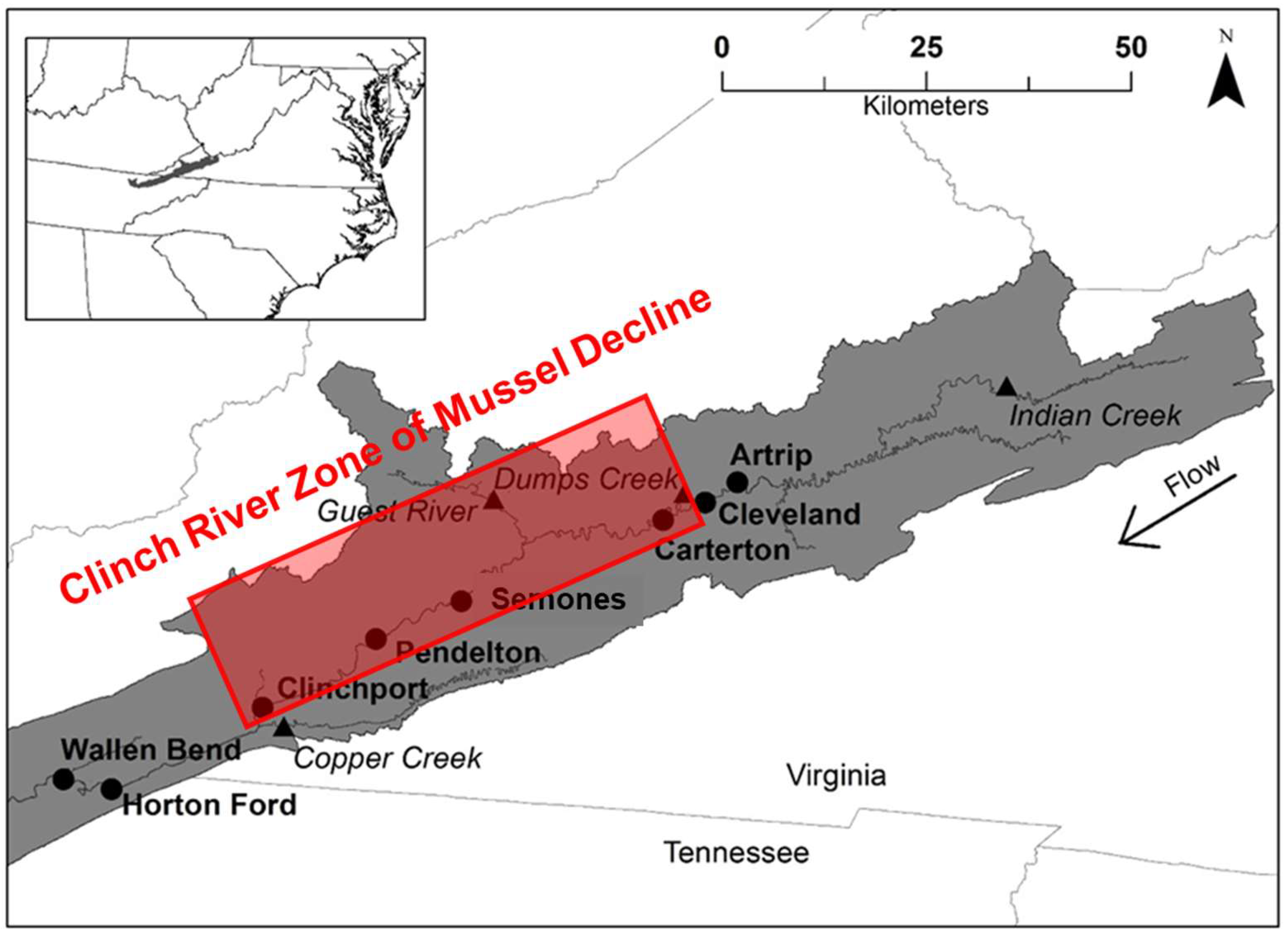
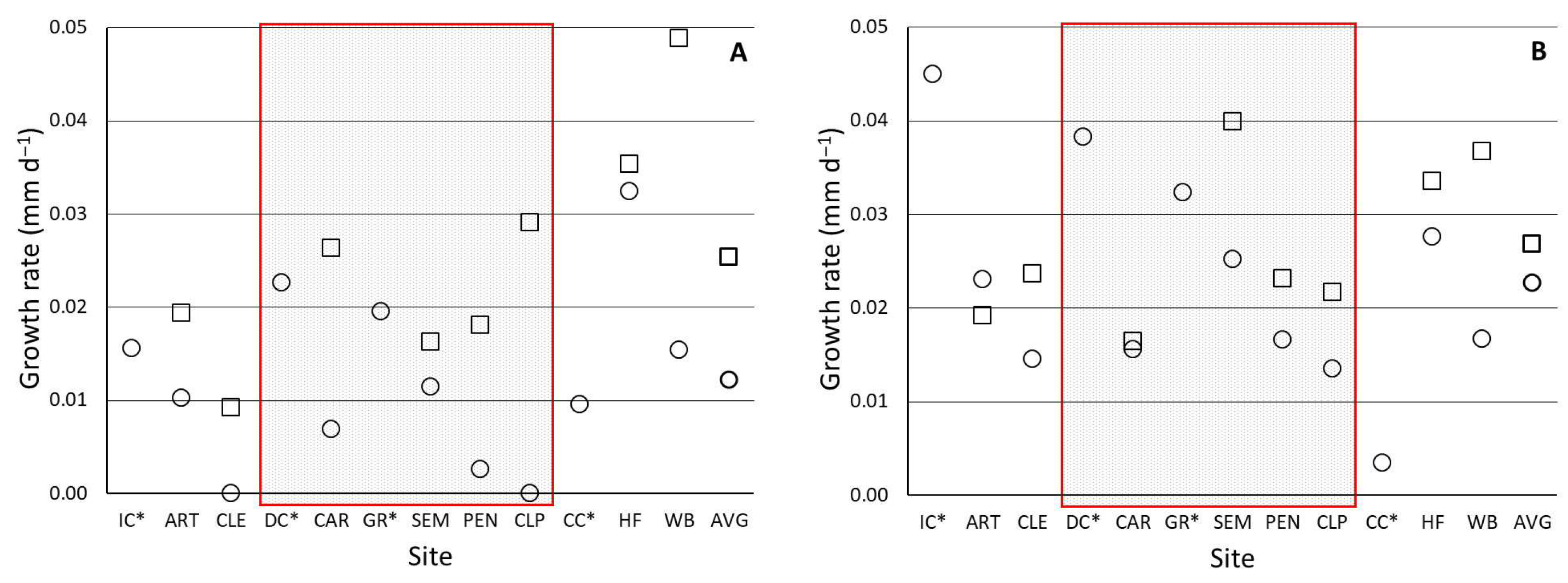


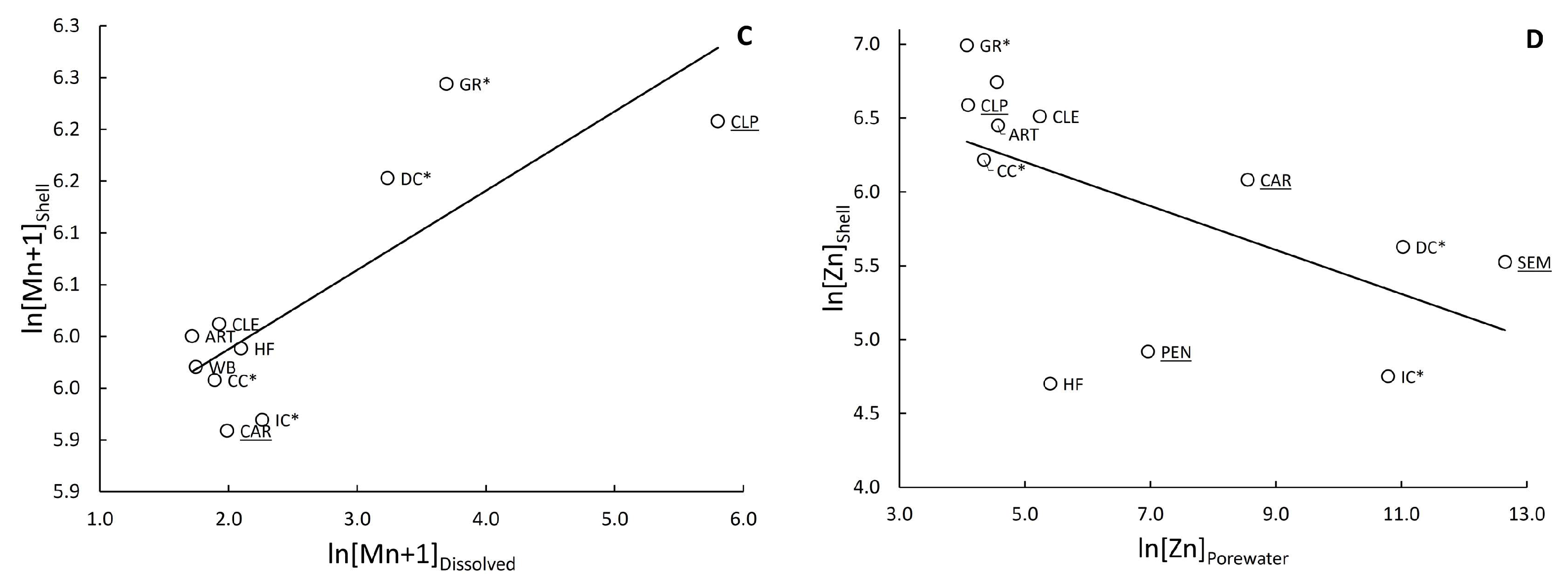
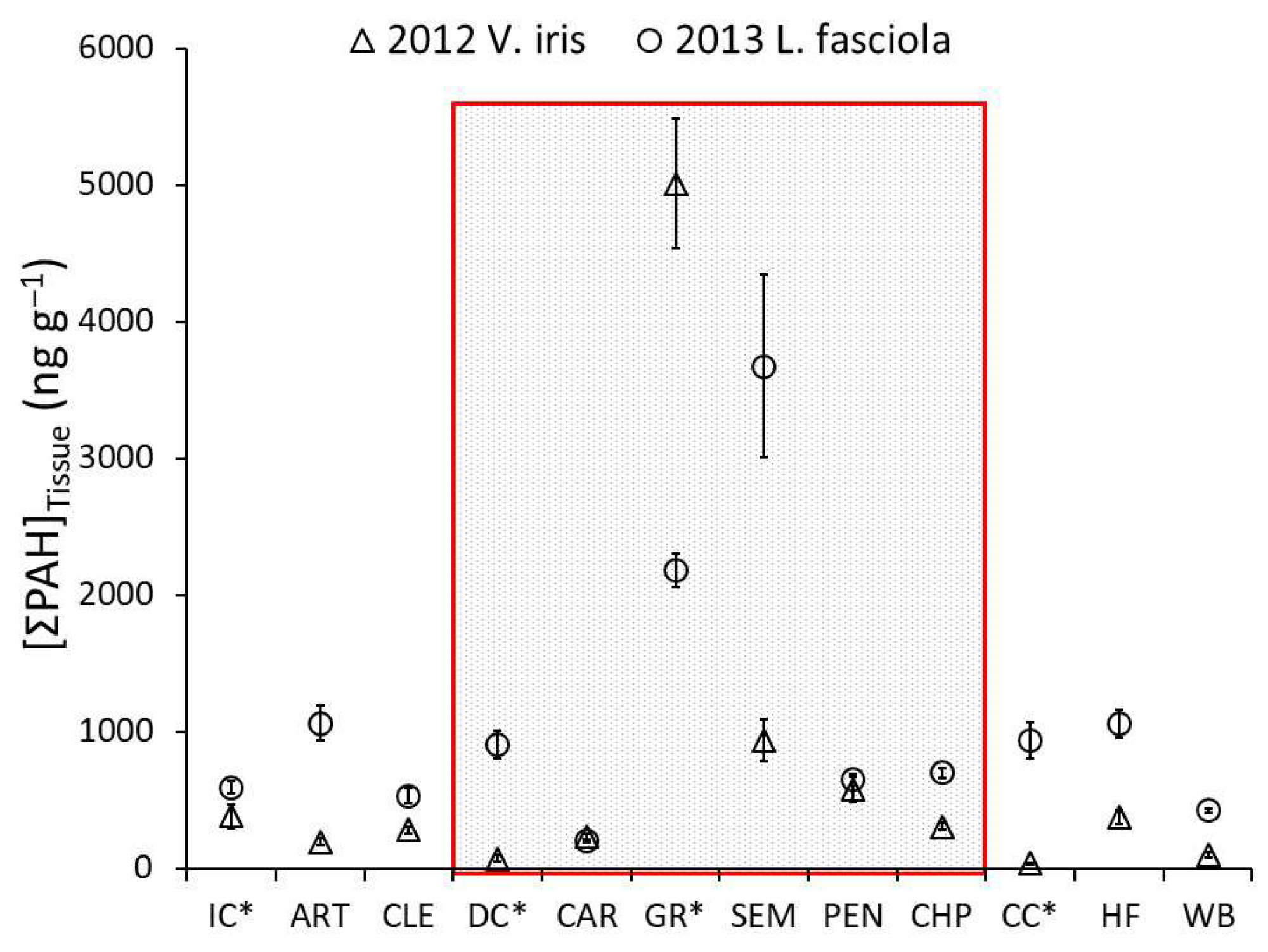

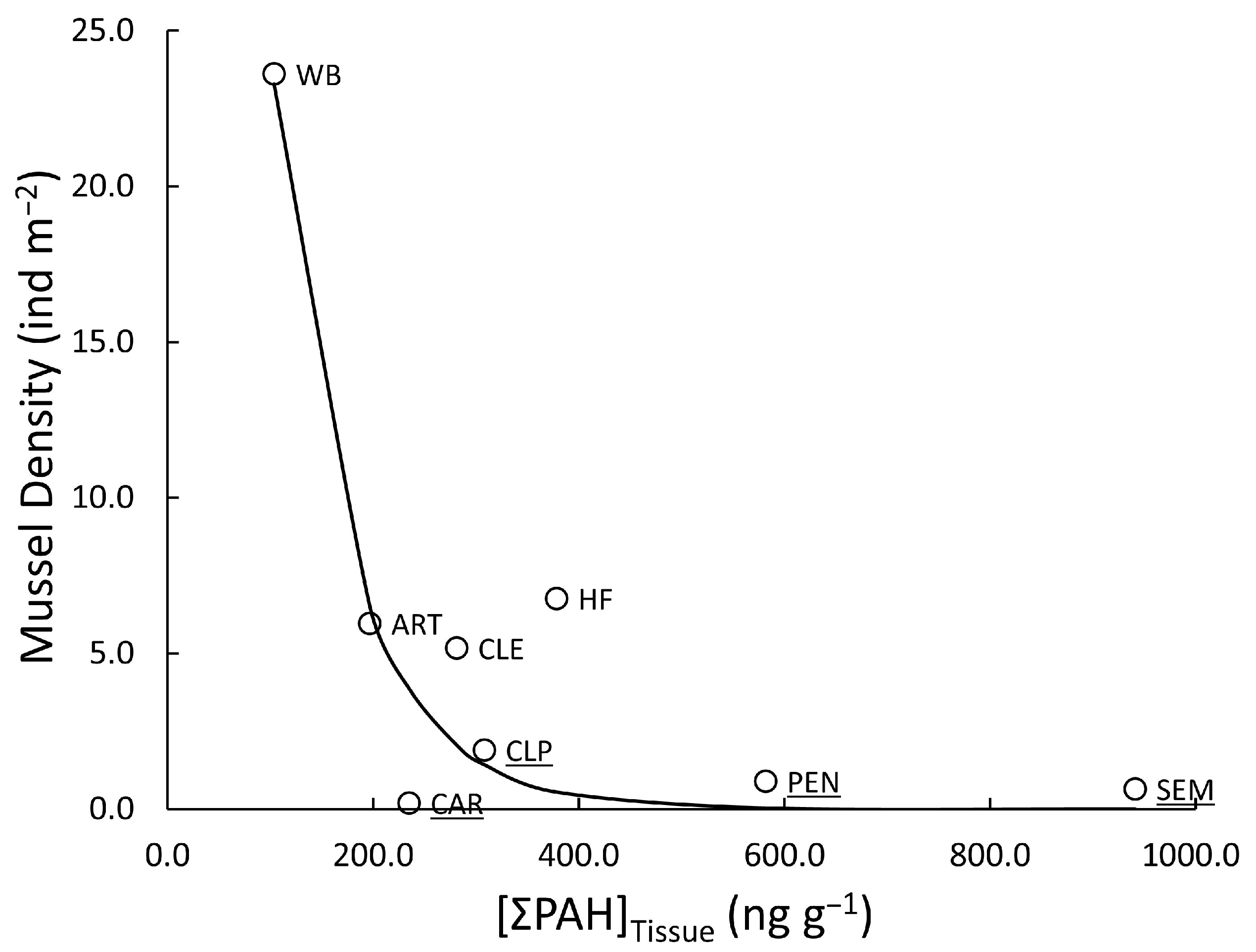
Disclaimer/Publisher’s Note: The statements, opinions and data contained in all publications are solely those of the individual author(s) and contributor(s) and not of MDPI and/or the editor(s). MDPI and/or the editor(s) disclaim responsibility for any injury to people or property resulting from any ideas, methods, instructions or products referred to in the content. |
© 2025 by the authors. Licensee MDPI, Basel, Switzerland. This article is an open access article distributed under the terms and conditions of the Creative Commons Attribution (CC BY) license (https://creativecommons.org/licenses/by/4.0/).
Share and Cite
Wilson, W.A.; Bergeron, C.; Archambault, J.; Unrine, J.; Jones, J.; Beaty, B.; Shea, D.; Lazaro, P.R.; Callihan, J.L.; Rogers, J.J.; et al. A Unionid Mussel Biodiversity Hotspot Experiencing Unexplained Declines: Evaluating the Influence of Chemical Stressors Using Caged Juveniles. Diversity 2025, 17, 503. https://doi.org/10.3390/d17080503
Wilson WA, Bergeron C, Archambault J, Unrine J, Jones J, Beaty B, Shea D, Lazaro PR, Callihan JL, Rogers JJ, et al. A Unionid Mussel Biodiversity Hotspot Experiencing Unexplained Declines: Evaluating the Influence of Chemical Stressors Using Caged Juveniles. Diversity. 2025; 17(8):503. https://doi.org/10.3390/d17080503
Chicago/Turabian StyleWilson, W. Aaron, Christine Bergeron, Jennifer Archambault, Jason Unrine, Jess Jones, Braven Beaty, Damian Shea, Peter R. Lazaro, Jody L. Callihan, Jennifer J. Rogers, and et al. 2025. "A Unionid Mussel Biodiversity Hotspot Experiencing Unexplained Declines: Evaluating the Influence of Chemical Stressors Using Caged Juveniles" Diversity 17, no. 8: 503. https://doi.org/10.3390/d17080503
APA StyleWilson, W. A., Bergeron, C., Archambault, J., Unrine, J., Jones, J., Beaty, B., Shea, D., Lazaro, P. R., Callihan, J. L., Rogers, J. J., & Cope, W. G. (2025). A Unionid Mussel Biodiversity Hotspot Experiencing Unexplained Declines: Evaluating the Influence of Chemical Stressors Using Caged Juveniles. Diversity, 17(8), 503. https://doi.org/10.3390/d17080503





